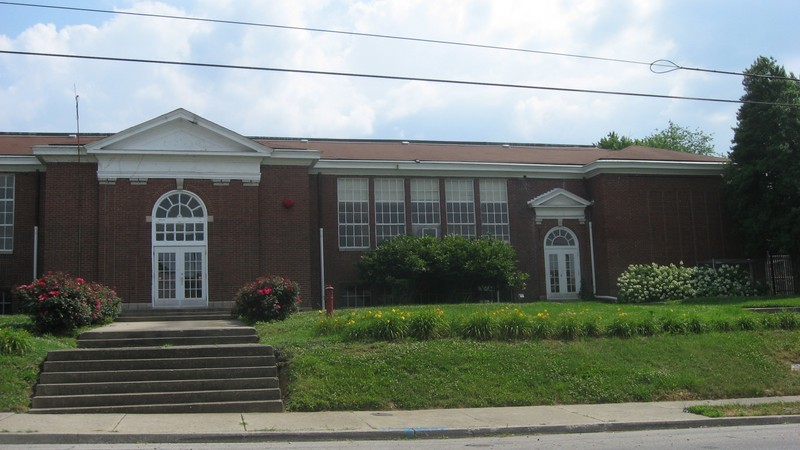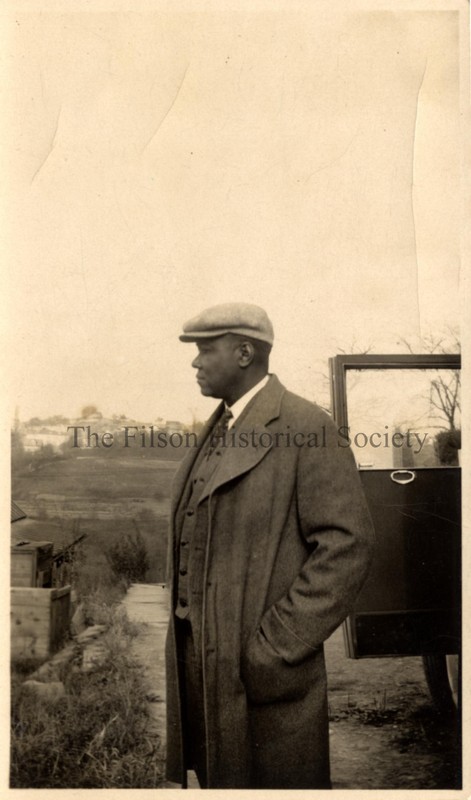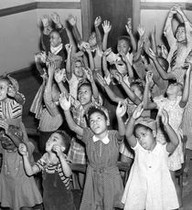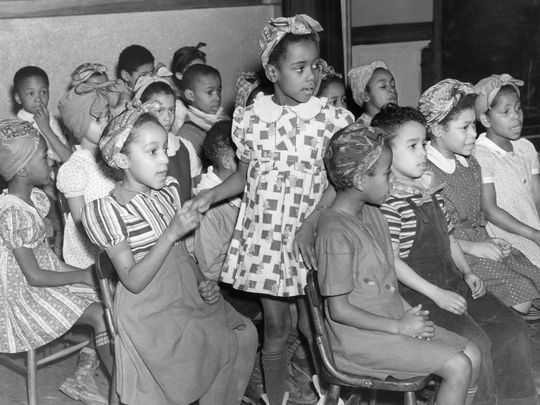Virginia Avenue Colored School
Introduction
Text-to-speech Audio
Images
Virginia Avenue "Colored" School (image from Wikimedia)

Architect Samuel Plato (image from the Filson Club Historical Society)

2nd and 3rd graders singing at the Virginia Avenue "Colored" School (image from Pinterest)

Elementary school students at the Virginia Avenue "Colored" School (image from the Courier-Journal)

Cookbook tribute to Samuel Plato - proceeds go to the West End School

Backstory and Context
Text-to-speech Audio
Historic Context - African American Education and the Parklands Neighborhood
Kentucky and its cities of Louisville, Lexington, and Covington were unusual in that they allowed schools for African Americans as early as 1827-1840. Most operated only for a few months a year, and were run by churches or independent teachers of either race, despite the fact that a public school system was established in 1829 for white Louisvillians. Following the Civil War, Louisville residents led by Horace Morris appealed to the Federal Government for equal treatment in education. Morris, a prominent Mason who had participated in the Underground Railroad in Ohio, was also steward of the U.S. Marine Hospital in Louisville.
The following year, the Freedmen's Bureau reported 15 schools in Kentucky, including a federally-funded building in Louisville; only three years later, African American schools in the state numbered 354 (in addition to 170 Sunday schools) and four high schools, some operated by the Freedman's Bureau itself. Still, however, schools for African Americans were primarily one-room schools with one teacher, only offering three months of classes per year. Funding and legislative complications made Louisville's establishment of a public education system for African Americans difficult, but public schools gradually increased and improved throughout the last quarter of the 19th century and the beginning of the 20th, with literacy rates improving by 28% between 1890 and 1910. Unfortunately, as public education became more available, segregation laws emerged both nationally and locally, with Black people excluded from schools and other facilities and services.
During the same time period (1870-1910), the Parkland area developed from a two-house plat to a small town to an urban neighborhood in West Louisville. In 1880, several African American families bought swampland property in southern Parkland, near the site of the present-day West End School. The community which grew to include six groceries, six churches including First Virginia Avenue Baptist, a pool hall, a private park, and 700 residents, was known as "Colored" or "Black Parkland" by whites, and "Needmore," "Tin Town," or "Little Africa" by African Americans. According to one "Little Africa" resident, the poet, educator, and community advocate Joseph S. Cotter, the nickname "Tin Town" originated from the fact that so many homes in the impoverished neighborhood were lined or roofed in flattened, lapped tin cans. Streets south of the segregation line at Greenwood Avenue were left unpaved and were nearly impassable. Parkland's first school, a three-month school for which parents had to pay a fee, was established in the Gibbs House, which had also held the first church services for First Virginia Avenue Baptist. From 1892-1906, Jacob Ross taught classes here, with a maximum of 75 pupils in a community with over 400 children.
The Virginia Avenue "Colored" School
In September of 1915, the Virginia Avenue "Colored" School opened in a portable frame building at 36th and Virginia Avenue. Campaigns to improve the community were held in the field next to the school, and as the neighborhood rapidly increased, a better and larger school facility quickly became a priority. A bond issue for the improvement of white public schools and the all-white University of Louisville received backlash from African American community leaders, who protested the overcrowding of Black schools. The Virginia Avenue School P.T.A. and a Democratic social activist, Patrick Henry Callahan, formed a coalition of both Black and white voters to publicly oppose and, in the end, defeat the bond issue in the 1920 election. A less exclusive bond issue passed, funding improvements for Louisville schools including the Virginia Avenue "Colored" School.
Black architect Samuel M. Plato (1882-1957) would design the first African American School in Louisville which was not housed in cast-off or dilapidated buildings. Plato was born in Alabama, learning carpentry from his father and attending Simmons University in Louisville for Architecture and Carpentry. He was one of the first African American architects in the nation, one of the first African American general contractors, and the first African American architect ever awarded a Federal Post Office Contract. With his reputation for excellent craftsmanship, style, and durability, he was asked to design at least 39 post offices, as well as 12 churches, 88 Federal housing units for which he earned the praise of First Lady Eleanor Roosevelt, 10 structures in Marion, Indiana (his home from 1902-1921), and a subdivision, two churches, several homes, and part of Simmons University's campus in Louisville (his home from 1921-1957). Plato also created an integrated workforce, promoted African American professional organizations, and won trade union membership for Black craftsmen.
The original brick and terra cotta Virginia Avenue School building was constructed in 1923, with wing additions built three years later for a cafeteria, gymnasium, assembly room, and 6 new classrooms. The first principal, presiding over a staff of four teachers, was Ms. Jessie R. Carter (from 1918-1926), who had graduated from Central "Colored" School in Louisville and graduated from Kentucky State College. "Colored" was dropped from the school name by Dr. Clyde A. Liggin, principal from 1934-1958, who also organized the first violin classes, school band, drama and glee clubs, and school newspaper, as well as establishing an African American history curriculum. Liggin also helped Parkland gain a Louisville branch library. But segregation and school overcrowding required ten portable classroom buildings by 1954, and even with the addition of the Southeast wing that same year, classes had to be held in the gymnasium.
1954 was also the year that the U.S.
Supreme Court ruled racial segregation to be unconstitutional. Unfortunately,
Kentucky took nearly twenty years to implement court-ordered desegregation, and
the City of Louisville hoped to put off the process by funding a more
substantial addition to the Virginia Avenue School in 1969, nearly obscuring
the original façade designed by Plato. The school was renamed in honor of its
first principal, Jessie Carter, in 1970, and desegregation of Louisville schools
was finally realized in 1975 under Principal Josephine B. Trowel, author of
"A History of the Virginia Avenue School," published during her
tenure as a teacher in 1956.
Sources
2. Indiana State Government. "Samuel Plato." Historic marker. Accessed March 30, 2017.
3. Jefferson County School System. "Carter Elementary School." Accessed March 30, 2017. http://schools.jefferson.kyschools.us/elementary/carter/index.html.
4. West End School. Official website. Accessed April 3, 2017. http://www.westendschool.org/our-story.html.
